Miniscule Flowers
by Valerie (November 13, 2002)
Our gardens are not terribly large and they are best appreciated in a close-up mode. Taking things a step further into the micro realm, some plants are so small that their flowers are barely visible unless viewed at very close quarters. The majority of these plants grow quite well for us and are considered to be noxious or invasive weeds in other areas.

There are few places left in our yard that get a good amount of sun and have some bare soil. One is the raised bed cactus garden. This small area is covered with rocks, gravel, and sand, with space between the various cacti and succulents growing there. It is perfect habitat for wind-blown seeds to germinate, if they prefer the heat and drought conditions. One plant the does admirably is purslane (Portulaca oleracea), a native annual. Also called pigweed, little hogweed and pusley, purslane is widespread in the U.S. It is closely related to another Portulaca, moss-rose, which is a showy annual used commonly for flower beds. Although it can be invasive in the right climate, it is too hot here for it to grow very large. The flowers are tiny and yellow, and the leaves and stems are succulent, but the plant only grows during the spring. It usually dries up completely during the summer, but sometimes the reddish colored stems survive to grow a bit more in the cooler temperatures of autumn.
Another annual that prefers the cactus gardens, Persian speedwell (Veronica persica) was introduced to this country from Asia. Also called bird's-eye, it has naturalized and often grows in grassy or bare areas. While very tiny, the blossoms are delightful, with blue and white stripes. The leaves are petite and scalloped, and exquisitely dainty. This plant follows the same growth habits as the purslane, appearing only when conditions are right, growing quickly, then dying off after producing seed.
Moving out of the cactus garden, one of the myriad components of our lawn is a common flower called henbit deadnettle (Lamium amplexicaule) or giraffe head. Henbit has very ornate purple flowers but they are so tiny, and the plant only grows about 5 inches tall, that they are most often noticed as just a speck of color in the general green foliage of the lawn. A naturalized import from Europe, it is an annual, but reseeds freely. It prefers to grow during mild weather, withering when the heat gets too high.
I'd noticed an attractive groundcover growing along the sidewalk in an area nearby where I like to walk. I decided to add it to our gardens and it easily transplanted and now we have a nice little patch of Texas frog-fruit (Phyla incisa). Also called sawtooth or wedgeleaf frog-fruit, this is a well-adapted perennial native that is perfect for covering hot, dry areas of soil. When it is in extremely dry places, it tends to hug the ground, but given water or more shady conditions and it grows a bit more upright, to about 8 inches. The flower heads are usually about ½ inch long and the blossoms themselves are tiny and white, opening in a ring. The leaves are rather long and stiff, with pronounced serrations on the edges. The plant roots wherever the stems touch the ground and it even blooms in the shade.
One area of our gardens has always had a creeping, weedy-looking plant, but I've only recently identified it as bristly mallow (Modiola caroliniana). It is also called creeping mallow, red-flowered mallow, and Carolina bristlemallow. The references to bristles have to do with the prickly hairs on the stems of the plant. The flowers are pretty, but tiny, and the seed pods are at least as attractive, |
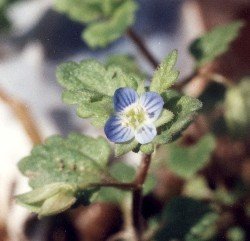 The plant produces a lot of seed, which forms in little capped cups that open to spill out their contents. When conditions are right again, the seeds readily germinate and the plants grace the garden with their rounded leaves and pretty little flowers. As with most annuals that grow in the cactus garden, I let them be until they have completed their life cycle, since they do no harm to the featured plants as they grow very sparsely.
The plant produces a lot of seed, which forms in little capped cups that open to spill out their contents. When conditions are right again, the seeds readily germinate and the plants grace the garden with their rounded leaves and pretty little flowers. As with most annuals that grow in the cactus garden, I let them be until they have completed their life cycle, since they do no harm to the featured plants as they grow very sparsely.
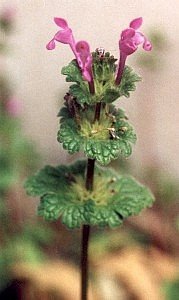
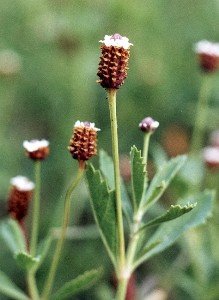
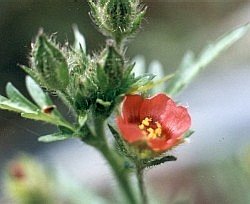
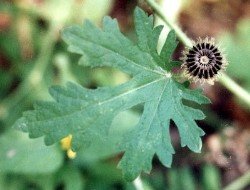 with their mandala-like symmetry. A hardy native perennial, this plant roots from the stem very easily, but doesn't seem to spread aggressively. It is common in grassy places, like along parking lots. One interesting feature of bristly mallow is that its leaves take on strikingly different forms during different seasons. In the autumn, the leaves are almost round and have tiny scallops on their edges, but in the spring, they are very deeply branched. The flowers and seeds are also produced only in the early part of the year, but the foliage remains healthy throughout the rest of the summer.
with their mandala-like symmetry. A hardy native perennial, this plant roots from the stem very easily, but doesn't seem to spread aggressively. It is common in grassy places, like along parking lots. One interesting feature of bristly mallow is that its leaves take on strikingly different forms during different seasons. In the autumn, the leaves are almost round and have tiny scallops on their edges, but in the spring, they are very deeply branched. The flowers and seeds are also produced only in the early part of the year, but the foliage remains healthy throughout the rest of the summer.